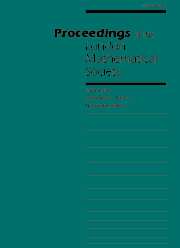No CrossRef data available.
Article contents
Distribution on C*-algebras associated with ℝn-actions
Published online by Cambridge University Press: 01 March 1997
Abstract
We construct a $C^*$-algebra version of the theory of distributions. For a $C^*$-algebra $A$ with an action $\alpha$ of $R^n$, the spaces $\cal D_{\alpha}^{\prime}(A)$ and $\cal S_{\alpha}^{\prime}(A)$ are introduced as an analogy of the classical spaces $\cal D^{\prime}(R^n)$ and $\cal S^{\prime}(R^n)$ of distributions on $R^n$. The original algebra $A$ is densely embedded into them as an $A^{\infty}$ (=the subalgebra of $A$ of all smooth elements)-bimodule.
Derivations coming from the action $\alpha$ are extended on them so that all elements of $A$ can be differentiable. Fourier transforms behave well on them. We prove that any member of $\cal D_{\alpha}^{\prime}(A)$ can be expressed as a finite linear combination of finite order derivatives of elements of the weak closure $A^{\prime\prime}$ of $A$. As a result, for any von Neumann algebra $M$ with an action $\alpha$ of $R^n$, the smallest completion of $M$ under differential calculus is given by our distribution space $\cal D_{\alpha}^{\prime}(A_M)$ for an associated $C^*$-algebra $A_M$ with action $\alpha$. The spectrum of an element of $\cal S_{\alpha}^{\prime}(A)$ is defined as support of its Fourier transform, which is a generalization of Arveson's spectrum. We then state the $C^*$-algebra version of the classical Paley-Wiener-Schwartz theorem which characterizes the condition that $\text{Sp}_{\alpha}(x)$ is compact in terms of the possibility of extension of the function $\alpha_t(x), t \in R^n$ to entire function of exponential type.
1991 Mathematics Subject Classification: primary 46L55, 46L89; secondary 46F25.
- Type
- Research Article
- Information
- Copyright
- London Mathematical Society 1997


